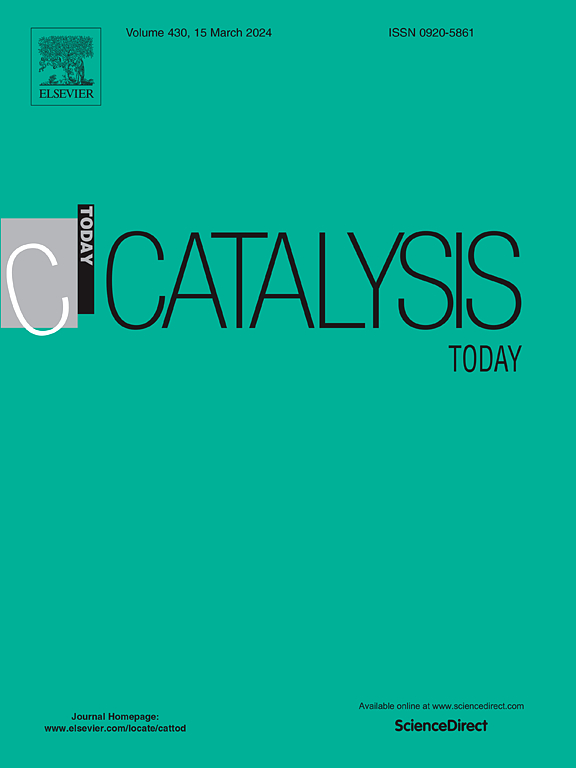二氧化钛上银纳米粒子光催化氧化二苯并噻吩化合物的表征和性能
IF 5.2
2区 化学
Q1 CHEMISTRY, APPLIED
引用次数: 0
摘要
在TiO2上合成了银纳米粒子,并对其进行了表征,以确定其作为光催化剂的潜力,并对其在光催化氧化二苯并噻吩化合物中的应用进行了评价。研究了Ag在TiO2结构上的掺入与Ag负载的关系。以1、3、5和10 wt%的Ag为负载制备催化剂,并通过扫描电子显微镜(SEM-EDX)、透射电子显微镜(TEM)、x射线衍射(XRD)、紫外-可见漫反射光谱(DRS)、光致发光(PL)光谱和电化学阻抗谱(EIS)对催化剂进行了表征。表征结果表明,Ag以纳米粒子的形式掺入到TiO2锐钛矿上,其掺入降低了带隙能和光生[e-/h+]物质的复合速率。此外,还确定了催化剂的导带能与O2/•O2-的还原电位接近,从而触发了催化剂表面上•O2-自由基的生成。这是由于局部表面等离子体共振效应,提高了载流子容量,从而提高了界面电子转移。在紫外-可见联合照射下,DBT、4- mdbt和4,6- dmdbt的光催化氧化在90 min内成功完成。值得注意的是,最顽固的化合物反应性更强,这与传统的非光催化脱硫体系的趋势相反。本文章由计算机程序翻译,如有差异,请以英文原文为准。
Characterization and performance of Ag nanoparticles on TiO2 for the photocatalytic oxidation of dibenzothiophene compounds
Ag nanoparticles on TiO2 were synthesized and characterized to determine its potential use as photocatalysts and then were assessed in the photocatalytic oxidation of dibenzothiophene compounds. The incorporation of Ag onto the TiO2 structure was investigated as a function of Ag loading. The catalysts were prepared with Ag loadings of 1, 3, 5 and 10 wt% and were characterized by scanning electron microscopy (SEM-EDX), transmission electron microscopy (TEM), X-ray diffraction (XRD), UV–vis diffuse reflectance spectroscopy (DRS), photoluminescence (PL) spectroscopy and electrochemical impedance spectroscopy (EIS). The characterization results showed that Ag was incorporated as nanoparticles onto TiO2 anatase and that their incorporation decreased the bandgap energy and the recombination rate of photogenerated [e-/h+] species. In addition, it was determined that the proximity of the conduction band energy of the catalysts to the reduction potential of O2/•O2- triggered the generation of •O2- radical on the catalytic surface. It was due to the localized surface plasmon resonance effect, improving the charge-carrier capacity and therefore the interfacial electron transfer. The photocatalytic oxidation of DBT, 4-MDBT and 4,6-DMDBT was successfully achieved in 90 min under a combined UV–vis irradiation. Noteworthy, the most recalcitrant compound was more reactive, in the opposite trend to that reported in the conventional non-photocatalytic desulfurization system.
求助全文
通过发布文献求助,成功后即可免费获取论文全文。
去求助
来源期刊

Catalysis Today
化学-工程:化工
CiteScore
11.50
自引率
3.80%
发文量
573
审稿时长
2.9 months
期刊介绍:
Catalysis Today focuses on the rapid publication of original invited papers devoted to currently important topics in catalysis and related subjects. The journal only publishes special issues (Proposing a Catalysis Today Special Issue), each of which is supervised by Guest Editors who recruit individual papers and oversee the peer review process. Catalysis Today offers researchers in the field of catalysis in-depth overviews of topical issues.
Both fundamental and applied aspects of catalysis are covered. Subjects such as catalysis of immobilized organometallic and biocatalytic systems are welcome. Subjects related to catalysis such as experimental techniques, adsorption, process technology, synthesis, in situ characterization, computational, theoretical modeling, imaging and others are included if there is a clear relationship to catalysis.
 求助内容:
求助内容: 应助结果提醒方式:
应助结果提醒方式:


